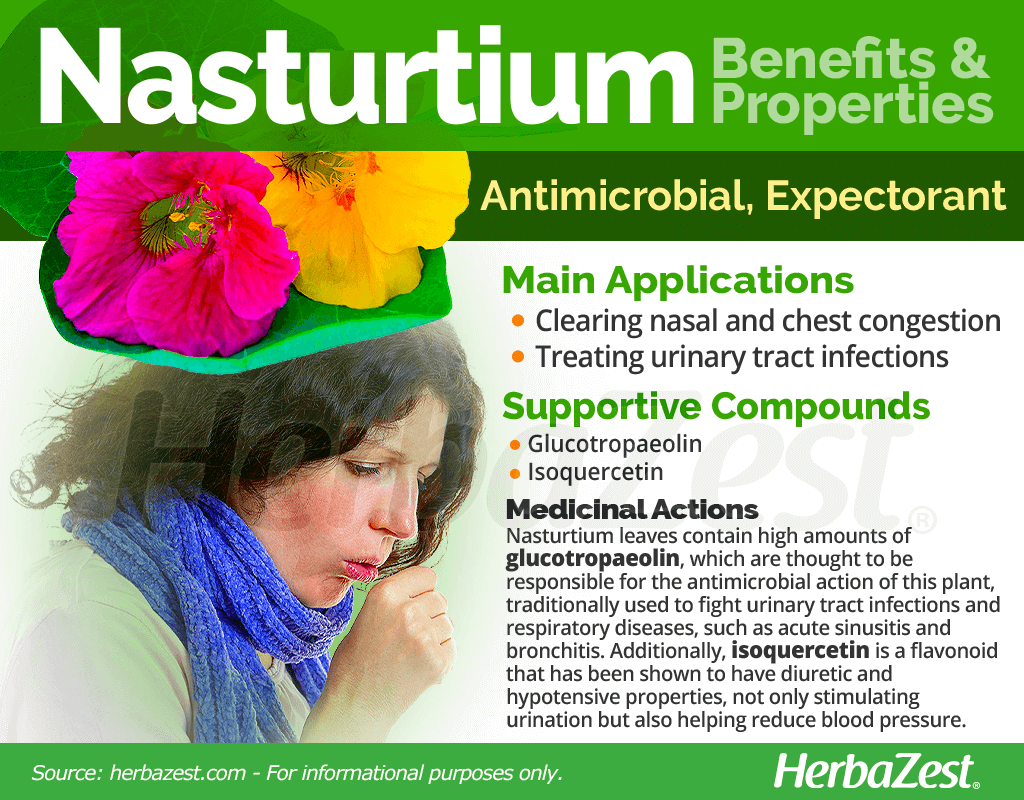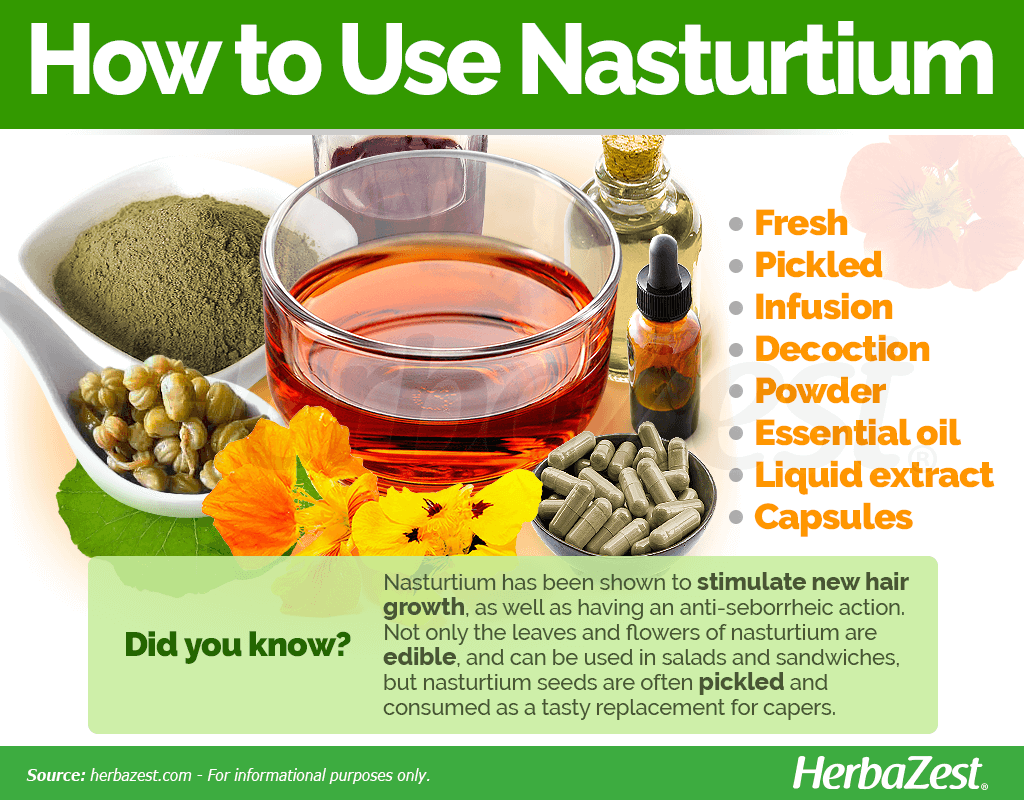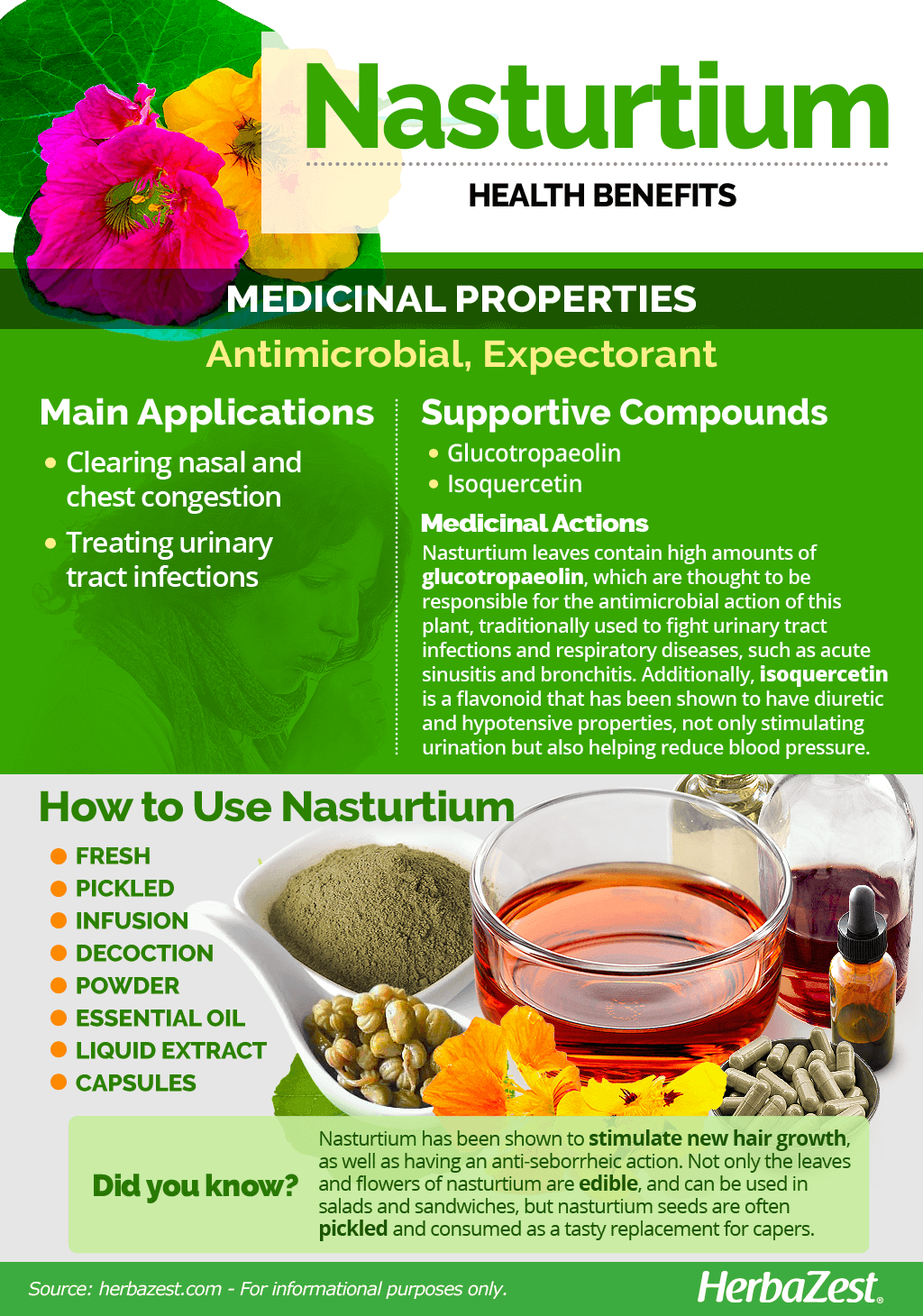Nasturtium, also known as Indian cress, climbing nasturtium, and garden nasturtium, is a beautiful perennial native to the Andean Mountains stretching down South America. All parts of this herb have been traditionally used to disinfect and heal wounds as well as treat urinary problems and respiratory conditions.
Nasturtium Medicinal Properties
- Medicinal action Antimicrobial, Expectorant
- Key constituents Glucotropaeolin, isoquercetin
- Ways to use Capsules, Decoctions, Hot infusions/tisanes, Liquid extracts, Food, Powder, Essential oil
- Medicinal rating (2) Minorly useful plant
- Safety ranking Safe
Health Benefits of Nasturtium
The expectorant, antimicrobial, and diuretic properties of nasturtium have found several uses in folk medicine. According to modern science, the main benefits of nasturtium are:
Clearing nasal and chest congestion. The herb is still used in South America for treating all kinds of respiratory illnesses, from colds and flu to sore throat and bronchitis.
Treating urinary tract infections. Nasturtium is consumed to stimulate urination and fight bacterial infections.
Additionally, nasturtium's properties have been traditionally used for:
Strengthening the immune system. Because it is high in vitamin C, it has been a popular remedy against scurvy and blood disorders.
Disinfecting the skin against bacteria and fungi. Its topical use is recommended for treating skin conditions, such as acne and eczema, as well as for preventing superficial wounds from getting infected.
How It Works
The active compounds of nasturtium include glucocyanates (specifically glycotropeoline), spilanthol, isoquercetin, myrosin, oxalic acid, and high doses of vitamin C.1
The high amounts of glucotropaeolin in the leaves of nasturtium are thought to be responsible for the antimicrobial action of the plant. They are used in traditional medicine to treat urinary tract infections.2 When the leaves are consumed, glucotropaeolin is transformed into mustard oils, which are absorbed in the intestine and excreted in the urine, exhibiting antimicrobial activity.
Nasturtium has shown antibacterial properties against harmful microorganisms, alongside antiviral and antifungal effects. Furthermore, the combination of nasturtium and horseradish root has shown to be effective in the treatment of acute sinusitis and bronchitis, offering a clear advantage over standard antibiotics.3
In addition, isoquercetin has diuretic and hypotensive effects due to its inhibition of angiotensin-converting enzyme (ACE), an enzyme that increases blood pressure by causing blood vessels to constrict.
Nasturtium has been shown to stimulate new hair growth as well as to have anti-seborrheic properties.4
Cranberry and echinacea are among the best options for the treatment of urinary infections, whereas eucalyptus and myrtle provide decongestant benefits. Additionally, jewelweed also provides relief from skin problems.
Nasturtium Side Effects
Modern research on nasturtium has not showed any toxicity. Nasturtium can interrupt implantation and make conception difficult due to its effects on the hormones dehydroepiandrosterone (DHEA) and estradiol. The herb can also act as an ACE inhibitor, relaxing blood vessels and potentially resulting in low blood pressure.5
When applied topically, nasturtium may cause skin irritation in sensitive people.
Nasturtium Cautions
Because of the effects this herb can have on blood pressure, those with high or very low blood pressure should consult a physician before taking nasturtium, and those with kidney disease should avoid it altogether.
Pregnant or nursing women, children, and people with poor health should not consume nasturtium.

How to Consume Nasturtium
- Edible parts Flowers, Leaves, Seed
- Edible uses Flavoring
- Taste Spicy, Tangy
Nasturtium leaves, flowers, and seeds have both medicinal and culinary applications. Some herbalists recommend that, in order to reap the benefits of nasturtium, it is best to use the fresh parts of the herb; however, nasturtium or Indian cress can also be found in a variety of supplemental forms, and home remedies can also be easily prepared.
Natural Forms
Fresh. Nasturtium leaves and flowers are edible, and their slightly peppery punch can be enjoyed in salads and sandwiches.
Pickled. Nasturtium seeds are great for pickling and are considered a worthy replacement of capers.
Infusion. The aerial parts of the plant - whether fresh or dried - can be steeped in hot water and drank in order to clear congested airways. A tea from the seeds is used for relieving constipation.
Decoction. The flowers and buds of nasturtium are boiled for 15 minutes. After straining the preparation, the liquid can be used as a rinse to stimulate air-growth as well as to treat seborrheic dermatitis.
Powder. The dried flowers, leaves, and stems of nasturtium are finely ground and can be used topically for treating skin problems, such as acne, eczema, and superficial wounds.
The mustard-like oil contained in the flowers and young buds of nasturtium makes them perfect for seasoning.
Herbal Remedies & Supplements
Essential oil. The essence of the nasturtium flower is often used in aromatherapy as a stimulant agent to boost energy and relieve stress.
Liquid extract. This medicinal form of nasturtium concentrates the sedative and antibiotic properties of the plant. A few drops mixed in a glass of water will be sufficient to reap its medicinal benefits. It can also be used topically as a skin-conditioning agent.
Capsules. This supplemental form of nasturtium is useful for fighting viral diseases and bacterial infections. It comes in fixed, easy to swallow doses.

Growing
- Life cycle Perennial
- Harvested parts Flowers, Seeds, Leaves
- Light requirements Full sun
- Growing habitat Arid or desert regions, Cool temperate regions, Mountain regions
- Planting time Summer, Late summer
- Potential insect pests Aphids, Leafhoppers, Mites, Caterpillars, Whiteflies
- Potential diseases Aster yellows, Viruses, Club root
Surprisingly, nasturtium flowers grow better in less fertile or poor soils with cool, sunny, and dry conditions. Once planted, nasturtium grows quickly.
Growing Guidelines
The seeds can be planted outdoors, but not until the danger of frost has passed.
The seeds can also be planted indoors, four weeks prior to the last frost date, but nasturtium does not typically fare well as a transplant.
Seeds need darkness to germinate.
If the climbing type is being grown, it will benefit from a trellis on which to vine.
Care should be taken not to over-fertilize nasturtium.
Nasturtium can be infested by aphids, caterpillars, leafhoppers, spider mites, and whiteflies.
Diseases such as Aster yellows, clubroot, fasciation, and viruses may also present a problem.
Additional Information
- Other uses Cosmetics, Repellent
Plant Biology
Nasturtium has two main types. The dwarf bush kind grows to be about 10 - 12 inches (25 - 30 cm) tall, while the climbing variety gets to be about 6 - 8 feet (2.0 - 2.5 m) tall. Its trumpet-shaped flowers come in many different colors, including red, pink, orange, yellow, cream, or a striped or mottled combination of these. Some types of the nasturtium flowers emit a pleasant fragrance, and their five petals grow to be about two inches (5 cm) across in total. The round leaves are generally 2 - 5 inches (5 - 12 cm) in diameter and can look like little umbrellas, depending on the variety.
Classification
Nasturtium, is a member of the family Tropaeolaceae and the genus Tropaeolum, which contains about 80 species. T. majus may also be referred to by its botanical synonym, T. nanum. Because of its common name, nasturtium, also known as garden nasturtium or Indian cress, is often confused with species that belong to the genus Nasturtium. This is due to the peppery taste of its flowers and buds, which is similar to watercress (Nasturtium officinale). However, both species are not related, and they don't even look alike.
Nasturtium is related to mashua (Tropaeolum tuberosum), an Andean crop with edible tubers that is also grown with ornamental purposes.
Varieties and Cultivars of Nasturtium
There are only two naturally occurring varieties of nasturtium: T. minus, which is a dwarf plant with small leaves; and T. majus, with larger leaves and climbing form. However, from those two main categories, dozens of cultivars have been created. The colors and shapes of flowers and leaves differ from cultivar to cultivar. For example, the 'Moonlight' cultivar is a vine with light yellow blooms, and the 'Tom Thumb Mixed' cultivar is a dwarf type with red, orange, and yellow flowers.
Historical Information
Carl Linnaeus, the man who laid the foundation for binomial nomenclature, named Tropaeolum majus after the Latin word for trophy, tropaeis. During historic wars, captured helmets were hung on posts as a symbol of victory. Linnaeus compared the vining nasturtium leaves to the abandoned shields and the bright flowers to the blood-stained helmets.
The first seeds of Nasturtium were brought to Europe from Peru by the Spaniards in the 16th century. Since that part of the world was called the West Indies, the plant was initially named Indian cress, which is still a popular name for nasturtium. T. minus arrived to Europe before T. majus; however, during the 1680s the larger, climbing variety of nasturtium took over.
John Parkinson, a great English herbalist and botanist, wrote about Indian cress in Paradisi in Sole (1629): "is of so great beauty and sweetnesse withall, that my garden of delight cannot bee unfurnished of it."
Other Uses
Pest control. Nasturtium is sometimes used as a trap crop for aphids, an infamous pest that sucks sap from plants all around the world. The nasturtium plant is also considered a good companion crop, because besides aphids, it repels a good number of other pests and is impervious to others. As a bonus, pollinators such as hummingbirds tend to be attracted to its bright flowers.
Cosmetics. Due to its antimicrobial and skin-healing properties, nasturtium extract is a popular ingredient in a variety of cosmetic products, such as moisturizers, shampoos, body washes, conditioners, liquid soaps, toners, blushes, and concealers.
Sources
- Cornell University, Nasturtium
- Edible & Medicinal Flowers, p. 56
- Medicinal Properties of Herbs and Plants
- Texas A&M Agrilife Extension, Nasturtium, Tropaeolum majus
- The Cultural History of Plants, p. 108
- The Environmental Working Group, Skin Deep, Cosmetic Database, TROPAEOLUM MAJUS (NASTURTIUM) EXTRACT
- University of Florida, Nasturtium, Garden — Tropaeolum majus
- University of Georgia, Tropaeolum majus
- University of Vermont, Tropaeolum majus
- Vegetable Gardening the Colonial Williamsburg Way, pp. 71 - 72
- Encyclopedia of Herbal Medicine, p. 278
- Medicinal Plants of the World, p. 326
Footnotes:
- Journal of Agricultural and Food Chemistry. (2008).The Glucosinolate−Myrosinase System in Nasturtium (Tropaeolum majus L.): Variability of Biochemical Parameters and Screening for Clones Feasible for Pharmaceutical Utilization. Retrieveved October 2, 2023, from: https://pubmed.ncbi.nlm.nih.gov/18986152/
- Arzneimittelforschung/Drug Research. (2006). Efficacyand safety profile of a herbal drug containing nasturtium herb and horseradish root in acute sinusitis, acute bronchitis and acute urinary tract infection in comparison with other treatments. Retrieveved October 2, 2023, from:https://pubmed.ncbi.nlm.nih.gov/16618018/
- Journal of Ethnopharmacology. (2012). Mechanisms underlying the diuretic effects of Tropaeolum majus L. extracts and its main component isoquercitrin. Retrieved October 2, 2023, from: https://pubmed.ncbi.nlm.nih.gov/22465728/
- Hair: Therapy & Transplantation. (2014). Conclusionsof the Multicentre International Trial to Assess Topical Application ofa Preparation Containing Capixil BG and Poliplant Capillar Complex in Patients with Alopecia Areata. Retrieved October 2, 2023, from: https://www.readcube.com/articles/10.4172%2F2167-0951.1000128
- Evidence-based Complementary and Alternative Medicine. (2014). EffectsofAngiotensin-Converting Enzyme Inhibitor Derived from Tropaeolum majus L. in Rat Preimplantation Embryos: Evidence for the Dehydroepiandrosterone and Estradiol Role. Retrieved October 2, 2023, from: https://www.hindawi.com/journals/ecam/2014/209207/





